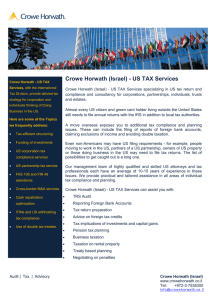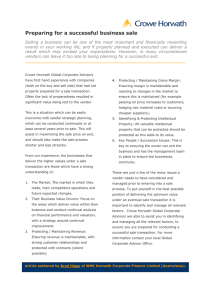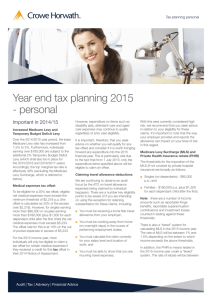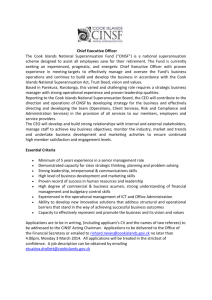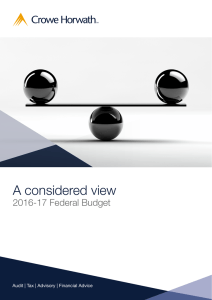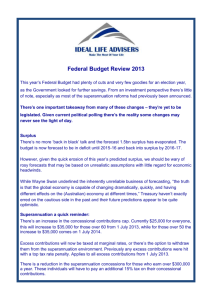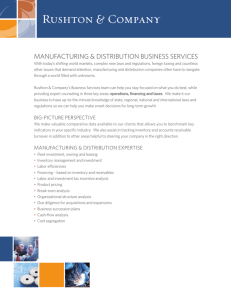Australian Federal Budget 2016/17 A delicate balance
advertisement
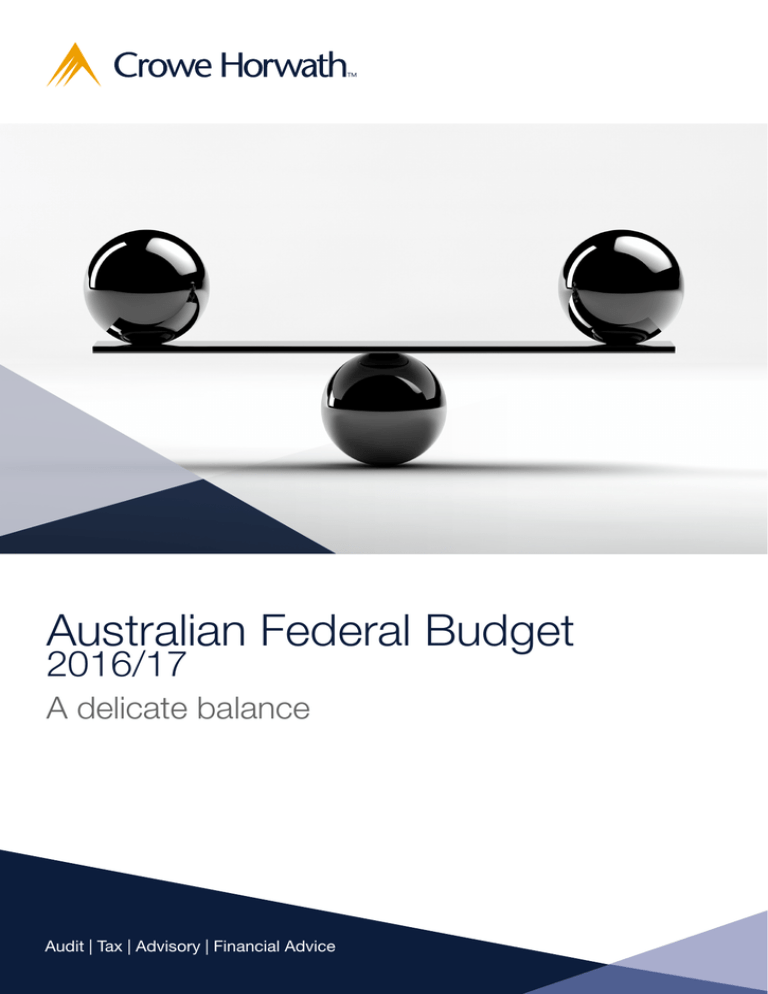
Australian Federal Budget 2016/17 A delicate balance Audit | Tax | Advisory | Financial Advice A delicate balance A delicate balance There is no doubt that Scott Morrison’s first Budget as Federal Treasurer is challenging. Major concerns about the state of the Australian economy emerged last week when the consumer price index (CPI) contracted 0.2 per cent in the three months to the end of March. This is the first serious bout of deflation for the Australian economy since the global financial crisis seven years ago. Falling prices are a drain on the economy as they discourage spending and investment. Consumer spending is reduced because it becomes more attractive to sit on cash reserves, while borrowing is also reduced as loans have to be repaid with dollars that are worth more than those originally borrowed. Governments have traditionally countered these sorts of problems with the fiscal stimulus of government spending. However, this is constrained by the need to reduce the Budget deficit. The major economic narrative of this Government’s first term has been reducing the deficit and, without a credible path back to surplus, it’s standing will be reduced in the eyes of a sceptical Australian public. This is particularly problematic with the spectre of the looming Federal election. The government has learnt the lesson of Joe Hockey’s first Budget: there is no appetite in the community for radical cuts to Government programs. This produces an extremely difficult problem for government ideologically opposed to higher taxes and big Government while attempting to pay down government debt and cut as little as possible. Juggling these competing priorities is a delicate balance for even the most seasoned Treasurer. Has Scott Morrison got the balance right? The government will want taxpayers to focus on jobs and growth, and argue that by tightening superannuation rules for both large balances and high income earners that this budget is fair. On the other hand, the opposition have pointed out that there are no tax breaks for families earning $37,000 to $80,000 p.a. and that government spending as a proportion of GDP is the highest it has ever been, absent a recession. Audit | Tax | Advisory | Financial Advice Our summary of last night’s budget highlights the biggest changes for you, your business and your family and helps you decide whether this Budget strikes the right balance. Background The Australian economy is entering its 26th consecutive year of economic growth and is expected to strengthen over the forecast period despite continuing uncertainty internationally. As our economy transitions from mining to broader-based growth, near-term economic activity will continue to be supported by household consumption, dwelling investment and exports - while falling mining investment is expected to continue to detract from growth over the forecast period. Over the current and next two financial years, the Budget forecasts a continuation of current economic conditions with moderate economic growth, little change in household consumption spending and modest employment growth. However, the housing market is forecast to cool and business investment to fall off substantially. The unemployment rate is forecast at 5 ¾ per cent in the current financial year, dropping to 5 ½ per cent in each of the following two years. Household consumption is expected to grow steadily, underpinned by strong employment growth. Historically low interest rates are supporting growth by lowering borrowing costs for both business and households, although the recovery in non-mining investment has been slower than expected. Individuals The Federal Budget delivers tax cuts for Australians earning more than $80,000, which is around what the average full time employee earns. Unfortunately, around 75% of Australians earn less than $80,000. This is because the average figure is based on full time employees (when a significant proportion of the workforce is part time) and the “average” figure is buoyed by those at the very top who are on very large salaries. This measure reduces the marginal income tax rate on taxable incomes between $80,000 and $87,000 from 37% to 32.5% from the 2016/17 income year. It should ensure that the average full-time wage earner will not move into the 37% tax bracket in the next three years. There is an estimated 500,000 taxpayers in this income tax bracket. For those earning more than $180,000, the budget deficit repair levy will be abolished from 1 July 2017 (as scheduled). Medicare levy The Medicare levy threshold for couples with or without children and seniors and pensioners living as singles or couples will increase as a result of changes made in the Budget. The increases simply take into account movements in the consumer price index (CPI) so that low-income earners generally continue to be exempted from the Medicare levy. The child-student component of the income threshold for all families also increases. The Budget also increases the Medicare levy surcharge low-income threshold in line with movements in the CPI. In addition, the pause in the indexation of the income thresholds for the Medicare levy surcharge and the private health insurance rebate will continue for a further three years. GST The GST will be extended to low value goods imported by consumers from 1 July 2017. The intent of this measure is that low value goods imported by consumers will face the same tax regime as goods that are sourced domestically. Overseas suppliers that have an Australian turnover of $75,000 or more will be required to register for, collect and remit GST for low value goods supplied to consumers in Australia, using a vendor registration model. Cigarettes and alcohol The Government will increase tobacco excise and excise equivalent customs duties through four annual increases of 12.5 per cent per year from 2017 until 2020. The increases will take place on 1 September each year and will be in addition to existing indexation to average weekly ordinary time earnings. It is estimated that by 2020 the average price of a packet of 25 cigarettes will be over $40. A delicate balance In addition, the Government will also limit, from 1 July 2017, the duty free tobacco allowance to 25 cigarettes or equivalent from the current allowance of 50 cigarettes. The Government will address integrity concerns with the wine equalisation tax (WET) rebate by reducing the WET rebate cap and tightening eligibility criteria for this scheme. In addition, the Government will extend the excise refund scheme to domestic spirit producers from 1 July 2017. Families Child care Due to the Family Tax Benefit reforms required to fund the child care package not being passed by the Senate, the Government will defer implementation of the Child Care Subsidy (Additional Child Care Subsidy and Community Child Care Fund) by one year to 1 July 2018. Child care fee assistance will continue to be provided under the Child Care Benefit, Child Care Rebate and other programs until 30 June 2018. The Interim Home Based Carer Subsidy Pilot Programme (Nanny Pilot Program), which commenced on 1 January 2016 and subsidises care provided by a nanny in a child’s home, will also be extended for six months to 30 June 2018. The hourly fee cap will be increased from $7 to $10 from 1 June 2016. Education The Government will provide $118.2 million over two years from 2016-17 in additional support for school students with a disability, targeted to those schools with the greatest need. The Government will provide an additional $1.2 billion over four years from 201718 to provide further funding support for government and non-government schools for the 2018 to 2020 school years. The additional funding will be based on the principles of being needs based, stable, simple, fair, transparent and is contingent on financial effort by the States and Territories and education reform by all sectors including improving literacy and numeracy, teaching and school leadership, and accountability to lift student outcomes. Audit | Tax | Advisory | Financial Advice Employment assistance The Government will provide an additional $88.6 million over four years from 2016-17 to expand the New Enterprise Incentive Scheme (NEIS) and to support self-employment opportunities for young people. From 1 December 2016, the Government will introduce a suite of initiatives to expand self-employment opportunities and encourage entrepreneurship among young Australians. The Government will provide $751.7 million over four years from 2016-17 to establish a Youth Jobs program for young job seekers aged under 25 years to improve youth employment outcomes. The new pathway is designed to enhance young people’s employability and provide up to 30,000 young people each year with real work experience. Business Small business (now, generally businesses with annual turnover of less than $10m) The centrepiece of changes to the taxation of small business is the cut to the company tax rate (referred to as the Ten Year Enterprise Tax Plan). The Government will reduce the company tax rate to 25 per cent over 10 years. Starting in the 2016-17 income year, the tax rate for businesses with an annual aggregated turnover of less than $10 million will be 27.5 per cent. This $10million threshold will then be progressively increased to ultimately have all companies at 27.5 per cent in the 2023-24 income year. The annual aggregated turnover thresholds for companies facing a tax rate of 27.5 per cent will be: • $25 million in the 2017-18 income year; • $50 million in the 2018-19 income year; • $100 million in the 2019-20 income year; • $250 million in the 2020-21 income year; • $ 500 million in the 2021-22 income year; and • $1 billion in the 2022-23 income year. In the 2024-25 income year the company tax rate will be reduced to 27 per cent and then be reduced progressively by 1 percentage point per year until it reaches 25 per cent in the 2026-27 income year. Franking credits will be able to be distributed in line with the rate of tax paid by the company making the distribution. Allied to these changes, the Government will increase the tax discount for unincorporated small businesses incrementally over 10 years from 5 per cent to 16 per cent. The tax discount will increase to 8 per cent on 1 July 2016, remain constant at 8 per cent for eight years, then increase to 10 per cent in 2024-25, 13 per cent in 2025-26 and reach a new permanent discount of 16 per cent in 2026-27. The current cap of $1,000 per individual for each income year will be retained. The tax discount applies to the income tax payable on the business income received from an unincorporated small business entity. Access to the discount will be extended to individual taxpayers with business income from an unincorporated business that has an aggregated annual turnover of less than $5 million. Definition of small business The Government will increase the small business entity turnover threshold from $2 million to $10 million from 1 July 2016. The current $2 million turnover threshold will be retained for access to the small business capital gains tax concessions, and access to the unincorporated small business tax discount will be limited to entities with turnover less than $5 million. An additional 90,000 to 100,000 business entities will gain access to concessions such as: the lower small business corporate tax rate, accelerated depreciation and a simplified method of paying PAYG instalments calculated by the ATO (which removes the risk of under or over estimating PAYG instalments and the resulting penalties that may be applied and depreciation pooling provisions,amongst others). Division 7A The anti-avoidance provision that most commonly hits small business taxpayers in the Tax Act is Division 7A of the Income Tax Assessment Act 1936. The Government will make long awaited amendments to improve the operation and administration of Division 7A. These changes will provide clearer rules for taxpayers and assist in easing their compliance burden while maintaining the overall integrity and policy intent of the provision. A delicate balance Farmers Big Business The Government will refine a two-year pilot program designed to improve farmer’s access to training and information about co-operatives, collective bargaining and innovative business models. The pilot was announced in the Agricultural Competitiveness White Paper. The revised program — to be known as the Farm Cooperatives and Collaboration Pilot — will focus on helping farmers to establish cooperatives and adopt innovative business, and will be delivered by Southern Cross University. Once again the Government is targeting multinational tax-avoidance with a suite of changes including: The Government will provide $7.1 million over four years from 2016-17 to maintain the additional rural financial counsellors in drought-affected areas, funded through the Agricultural Competitiveness White Paper (the White Paper). The additional funding in the White Paper was a one-off measure for 2015-16 to provide increased resources to service providers in droughtaffected areas. Continuing this funding will provide the equivalent of 15 extra counsellors each year to assist farming families to manage issues associated with drought and drought recovery. The funding will be targeted to regions in need, assessed on the basis of prevailing drought conditions. Water The Government will provide $2 billion in concessional loan funding for a 10 year period from 1 July 2016 to establish the National Water Infrastructure Loan Facility. Loans will be provided to the States and Territories to support major water infrastructure projects. Applications for loans will be assessed against the project’s cost effectiveness and financial viability. The loan recipient will make interest-only payments for up to the first five years of the loan term and will then have a further 10 years to repay the principal and any additional interest. The Government will introduce a National Register of Foreign Ownership of Water Entitlements (the Register). The Register will require foreign persons to notify and update their interests in water entitlements with the Australian Taxation Office (ATO), effective from 1 July 2017. Audit | Tax | Advisory | Financial Advice • A 40% diverted profits tax (DPT) on the profits of multinational corporations that are artificially diverted from Australia will be introduced from 1 July 2017. • A mending transfer pricing rules to give effect to OECD recommendations, effective from 1 July 2016. • A dopting rules developed by the OECD to eliminate hybrid mismatch arrangements. These changes will be implemented from 1 January 2018. • A dministrative penalties imposed on significant global entities will be increased from 1 July 2017. Tax consolidated groups The Budget addresses the tax benefit arising from the double counting of deductible liabilities under the tax consolidation regime. In addition, the treatment of deferred tax liabilities under the tax consolidation regime will be amended by removing adjustments relating to deferred tax liabilities from the consolidation entry and exit tax costsetting rules. These rules will be discussed further in our supplementary “Considered View” Budget paper to be released later this week. The taxation of financial arrangements The taxation of financial arrangements (TOFA) rules will be reformed to reduce their scope, decrease compliance costs and increase certainty. The measure contains the following components: • a “closer link to accounting” to strengthen and simplify the existing link between tax and accounting in the TOFA rules • s implified accruals and realisation rules (which will reduce the number of taxpayers that come within the TOFA rules), to reduce the arrangements where spreading of gains and losses is required under TOFA and simplify the required calculations • a new tax hedging regime which is easier to access, encompasses more types of risk management arrangements (including risk management of a portfolio of assets), and removes the direct link to financial accounting, and • s implified rules for the taxation of gains and losses on foreign currency to preserve the current tax outcomes but streamline the legislation. The reform of the TOFA rules is intended to remove the majority of taxpayers from the TOFA regime, resulting in lower compliance costs, provide simpler rules and more certainty. Superannuation In contrast to the most recent Federal Budgets, Superannuation bore the brunt of changes to the tax and transfer system, with the Government announcing a comprehensive package of targeted reform measures that will reduce the quantum of concessional treatment afforded to money moving into the superannuation environment. Key Measures 1. Reducing the Amount of Concessional Tax Treatment of Contributions T he Government will reduce the annual cap on concessional superannuation contributions from 1 July 2017 to $25,000 down from $30,000 for those below 50 and $35,000 for those aged 50 and over at present. A dditional Superannuation contributions tax will need to be paid by those who earn $250,000 or above, down from $300,000 currently, from 1 July 2017. T he Government will also include notional (estimated) and actual employer contributions in the concessional contributions cap for members of unfunded defined benefits schemes and constitutionally protected funds. Existing grandfathering arrangements will continue for members of a funded defined benefits scheme, as at 12 May 2009. 2. Winding Back the Tax-Free Earnings Environment for Pensions T he tax exemption on earnings of assets supporting Transition to Retirement Income Streams will be removed from 1 July 2017. The usual 15% superannuation tax rate on earnings and discounted capital gains will apply. A rule that allows individuals to treat certain superannuation income stream payments as lump sums for tax purposes will also be removed. A delicate balance A balance cap of $1.6 million on the total amount of accumulated superannuation an individual can transfer into the tax-free retirement phase will be introduced from 1 July 2017. Where an individual accumulates amounts in excess of $1.6 million, they will be able to maintain this excess amount in an accumulation phase account (where earnings will be taxed at the concessional rate of 15 per cent). Members already in the retirement phase with balances above $1.6 million will be required to reduce their retirement balance to $1.6 million by 1 July 2017. Excess balances for these members may be converted to superannuation accumulation phase accounts. Commensurate treatment for members of defined benefit schemes will be achieved through changes to the tax arrangements for pension amounts over $100,000 from 1 July 2017. 3. A Lifetime cap for NonConcessional Superannuation Contributions A lifetime non-concessional contributions cap of $500,000 will be introduced and will replace the existing annual caps of $180,000 p.a. or $540,000 in a three year period. The cap will be indexed to average weekly ordinary time earnings. The lifetime cap will take into account all non-concessional contributions made on or after 1 July 2007, from which time the ATO has reliable contributions records, and will commence at 7.30 pm (AEST) on 3 May 2016. Contributions made before commencement cannot result in an excess. However, excess contributions made after commencement will need to be removed or subject to penalty tax. C ontributions made into defined benefits accounts and constitutionally protected funds will be included in an individual’s lifetime non-concessional cap. If a member of a defined benefits fund exceeds their lifetime cap, ongoing contributions to the defined benefits account can continue but the member will be required to remove, on an annual basis, an equivalent amount (including proxy earnings) from any accumulation account they hold, limited to the amount of non-concessional contributions made into those accounts since 1 July 2007. Contributions made to a defined benefits account will not be required to be removed. 4. Carrying Forward Unused Concessional Contribution Caps F rom 1 July 2017, individuals who have less than $500,000 accumulated in superannuation will be permitted to make additional concessional contributions where they have not reached their concessional contributions cap in previous years. Amounts are carried forward on a rolling basis for a period of five consecutive years, and only unused amounts accrued from 1 July 2017 can be carried forward. 5. Increasing the age for contributions to Superannuation eople under the age of 75 will no longer P have to satisfy a work test in order to make Superannuation contributions and will be able to receive contributions from their spouse. This will result in the same contribution acceptance rules for all individuals aged up to 75 from 1 July 2017. Contact us Tel 1300 856 065 www.crowehorwath.com.au 6. Opening up tax deductions for personal Superannuation contributions to Employees F rom 1 July 2017 all individuals up to age 75 will be allowed to claim an income tax deduction for personal superannuation contributions, up to the concessional contributions cap. This applies regardless of their employment circumstances. Individuals that are members of certain prescribed funds would not be entitled to deduct contributions to those schemes. Prescribed funds will include all untaxed funds, all Commonwealth defined benefit schemes, and any State, Territory or corporate defined benefit schemes that choose to be prescribed. 7. Introducing a Low Income Superannuation Tax Offset A low income superannuation tax offset (LISTO) will be introduced to reduce tax on superannuation contributions for low income earners from 1 July 2017. It will provide a non‑refundable tax offset to superannuation funds, based on the tax paid on concessional contributions made on behalf of low income earners, up to a cap of $500. 8. Low Income Spouse Tax offset T he income threshold for the receiving spouse (whether married or de facto) will apply to members with adjusted taxable income up to $37,000 that have had a concessional superannuation contribution made on their behalf. The low income spouse tax offset provides up to $540 per annum for the contributing spouse. 9. Removal of Anti-detriment Provision T he anti-detriment provision in respect of death benefits from superannuation will be removed from 1 July 2017. The relationship you can count on Crowe Horwath (Aust) Pty Ltd | ABN 84 006 466 351 Findex Advice Services Pty Ltd | ABN 88 090 684 521 | AFSL 243253 | trading as Crowe Horwath Financial Advice Crowe Horwath (Aust) Pty Ltd and Crowe Horwath Financial Advice have exercised reasonable care in preparing this content but accepts no liability, under any theory of liability, including but not limited to in tort, in contract, under statute or in equity, for any loss sustained by any person as a result of relying on any advice contained herein. Crowe Horwath (Aust) Pty Ltd and Crowe Horwath Financial Advice recommend that you seek personal financial advice tailored to your needs before making any decisions. All information, opinions, conclusions, forecasts or recommendations are current at the time of compilation but are subject to change without notice. Crowe Horwath (Aust) Pty Ltd and Crowe Horwath Financial Advice assume no obligation to update this content after it has been issued. This material has been prepared without taking into account your objectives, financial situation or needs, and therefore you should consider if the information suits your needs before making a decision. Crowe Horwath (Aust) Pty Ltd is a member of Crowe Horwath International, a Swiss verein. Each member firm of Crowe Horwath is a separate and independent legal entity. Liability limited by a scheme approved under Professional Standards Legislation (other than for the acts or omissions of financial services licensees) in each State or Territory other than Tasmania. Findex Advice Services Pty Ltd trading as Crowe Horwath Financial Advice is not a member of Crowe Horwath International. Crowe Horwath (Aust) Pty Ltd and its affiliates, including Crowe Horwath Financial Advice, are not responsible or liable for any acts or omissions of Crowe Horwath or any other member of Crowe Horwath and specifically disclaim any and all responsibility or liability for acts or omissions of Crowe Horwath or any other Crowe Horwath member.
